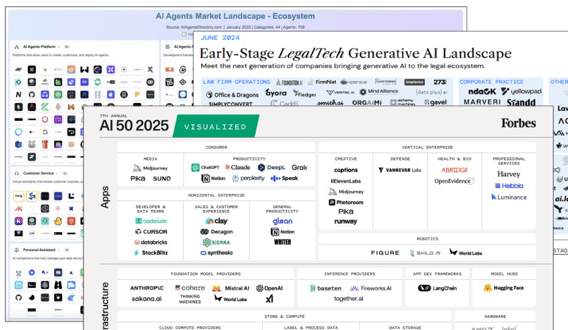In a surprising turn of events, a new player in the world of artificial intelligence has sent...
Harmonizing Your AI Tools: The Strategic Imperative for IT Leaders
 Daniel Whitenack
·
5 minute read
Daniel Whitenack
·
5 minute read
The rapid proliferation of AI tools has created a strategic paradox for enterprise IT leaders. On one hand, AI offers unprecedented efficiency and innovation; on the other, the sheer number of available tools, from specialized legal tech to general-purpose chatbots, has generated a fragmentation crisis. For IT, this is not just an administrative headache; it is a critical governance, security, and financial threat. The landscape is a dizzying mix: agents, vertical SaaS, low-code platforms, and custom development kits.

Figure 1
The Invisible Threat: Shadow AI
When an organization fails to provide a secure, sanctioned path for AI usage, teams inevitably turn to external, unauthorized tools to meet business needs. This Shadow AI introduces significant, unmanaged risks:
- Data Leakage: Proprietary, client, or sensitive internal data is unknowingly transmitted to third-party public models.
- Security Gaps: Unaudited tools lack corporate security and compliance controls, making the enterprise vulnerable to prompt injection and other attacks.
- Unpredictable Costs: Teams may use expensive consumption-based APIs without central oversight, leading to budget surprises.
What Not To Do: Failed Strategies
Effective AI Harmonization is about enablement, not control for its own sake. Three common, counterproductive reactions must be avoided:
- The Blockade: Pretending to "block" all AI tools simply drives usage underground, guaranteeing unmanaged Shadow AI.
- The Rigid Mandate: Providing only a limited, top-down list of "approved" tools, especially if they are inferior or cumbersome, frustrates innovation and encourages teams to bypass the system.
- The Hands-Off Approach: Establishing "rules" without providing an approved, best-in-class platform for compliance leaves teams without a viable path to security.
The goal for the IT leader is to transition from a gatekeeper to an enabler, establishing a secure, governed foundation that can power all AI initiatives.
(Step 1) The Harmonization Strategy (Mental Models)
To harmonize effectively, IT must first classify the use cases to understand the required governance. This requires establishing a clear AI Tool Mental Model. AI tools can be categorized into five distinct layers:
|
Tool Category |
Description |
Governance Priority |
|
1. AI Platform |
The foundational infrastructure that provides the actual AI model serving, security, and API access (e.g., Prediction Guard). |
Highest. The core control point for data flow and governance. |
|
2. General Chat |
Broad, public-facing applications (e.g., ChatGPT, Copilot, or Open WebUI). |
High. Requires clear policy on what data can be input. |
|
3. AI Integration |
AI powered features in existing software platforms (e.g., Workday or Teamcenter) |
Medium. Must connect exclusively to the sanctioned AI Platform. |
|
4. Low-Code/No-Code |
Visual, non-technical tools for building AI workflows (n8n, LangFlow, etc.) |
Medium. Compliance is inherited from the underlying platform. |
|
5. Custom Development |
Bespoke applications developed from scratch or using frameworks like LangChain, LlamaIndex, etc. |
High. Requires the strongest internal governance and deployment via the AI Platform. |
This mental model clarifies that the AI Platform is the strategic layer where the most critical governance decisions are implemented.
(Step 2) Determine Your Constraints (The IT Blueprint)
Before choosing a platform, IT leadership must define the non-negotiable constraints. These factors will immediately filter out unsuitable solutions and guide the path to harmonization.
- Data Flow: Where does the data need to live? Are there restrictions on sending PII/PHI/IP outside the corporate network? This is often the most critical filter.
- Regulatory Burden: What specific compliance regimes (e.g., HIPAA, GDPR, industry-specific regulations) must be met? Compliance often dictates the acceptable deployment environment.
- Deployment Environment: Does the solution need to run in a private cloud VPC, hybrid environment, or an air-gapped on-premise data center?
- Cost Model: Does the business require predictable, fixed costs, or is it acceptable to scale with variable consumption-based expenses?
These constraints form the essential blueprint for the core decision: Do we own the platform, or do we rent the access?
(Step 3) The Crux of Control (Choosing Your Core AI Platform)
For IT leaders, the choice of the AI Platform is the single most important decision for long-term governance and financial stability. This choice fundamentally determines your control over data, security, and costs. The decision boils down to two architectures:
|
Feature |
Option A: Consumption APIs (Third-Party Platforms) |
Option B: Self-Hosted AI Platform (e.g., Prediction Guard) |
|
Data Flow |
Data is sent offsite to the third-party provider. |
All data stays inside the campus/corporate network. |
|
Infrastructure |
Third-party controls all infrastructure, models, and updates. |
Your organization controls the entire infrastructure and model stack. |
|
Cost Model |
Consumption-based APIs (pay-per-token). |
Fixed monthly cost, unlimited seats, predictable budgeting. |
|
Flexibility |
Limited to the provider's model offerings. |
Complete model optionality: Use open-source, deploy your own custom models, or choose from a curated library. |
The Case for Self-Hosted Control
The Self-Hosted AI Platform is the only strategic option that allows IT leaders to fully satisfy the most common enterprise constraints—namely, data sovereignty, fixed cost, and custom deployment.
- Data Sovereignty: By deploying the platform on-premise or within a private VPC, no prompt data or proprietary information ever leaves the institution's infrastructure. This immediately solves the data flow constraint for regulated industries.
- Risk Mitigation: The platform becomes the unified, audited gateway for all internal AI usage, ensuring real-time monitoring and applying safeguards (PII masking, toxicity detection, prompt injection defense) before data ever reaches the model.
- Compliance Certainty: Full control over the infrastructure means the platform can be deployed in a manner that explicitly fits your organization's unique regulatory posture, moving away from relying on vendor "compliant tiers."
The Self-Hosted model transforms a critical IT function from a variable rental expense into a controlled, audit-ready, internal utility.
Strategic Trade-Offs (Cost, Security, and Predictability)
While Consumption APIs offer low upfront investment, the trade-offs in the long run prove costly and strategically limiting. For IT leaders tasked with long-term platform health, the focus must shift from initial cost to Total Cost of Ownership (TCO) and Risk Profile.
Consumption APIs are optimized for scaling with use, which translates to less predictable cost and significant expense at high scale. This unpredictable model makes strategic budgeting nearly impossible and can lead to mid-year budget crises as AI usage spikes. A fixed-price deployment, like that offered by Prediction Guard, is optimized for the long term. While more expensive upfront (requiring investment in hardware or cloud compute), the monthly subscription remains constant, allowing for unlimited seats and unlimited usage. This TCO calculation clearly favors the fixed-price model as the organization scales its AI initiatives across hundreds or thousands of employees.
2. Security and Regulatory Burden:
Data transfer is the single biggest security risk. When utilizing Consumption APIs, you are reliant on a third party's security posture and the promise that your data won't be used for model training. Furthermore, compliance requires you to trust that the third-party’s deployment meets your specific regulatory burden. With a self-hosted platform, the infrastructure is yours. You own the compute layer and the orchestration layer. This full control means:
- Auditability: You maintain a complete audit trail of every model input, output, and version change—a non-negotiable requirement for high-compliance environments.
- Hardware Optionality: The platform can be deployed on a mix of existing on-premise GPUs, cloud compute, or even efficient hardware like commodity CPUs, ensuring the solution is perfectly tailored to your hardware budget and performance needs.
Relying on a third-party API leads to vendor lock-in, restricting you to their available models and pricing. A self-hosted platform separates the AI infrastructure from the model choice. It provides complete model optionality, allowing IT to host best-in-class open-source models, experiment with new architectures, or even bring in custom, fine-tuned corporate models—all within a unified, governed environment. This agility is key to future-proofing the AI strategy.
(Step 4) Encouraging Transparency and Real-World Harmony
The final step in harmonization shifts from infrastructure design to cultural enablement. Having established a secure AI Platform foundation, IT leaders can move from policing usage to encouraging AI usage and transparency. The strategy is simple: provide a path that is so effective and secure that employees want to use the approved system.
To combat Shadow AI, IT must actively partner with business units to understand their needs and then provide an approved, guardrailed route to meet those needs. This alignment ensures that best-in-class usage complies with corporate constraints.
Here are three examples of how a harmonized AI Platform can power diverse enterprise applications, all while ensuring data governance and cost predictability:
- AI Code Assistants: Instead of letting developers use a public code helper that sends proprietary code offsite, IT deploys the internal AI Platform with a dedicated open-source coding model. Developers can integrate their favorite tools (like Cursor or VS Code via plugins) directly via the platform's standard API, ensuring all code remains within the corporate network.
- Workday or ERP Integrations: Business units want to use AI to summarize HR reports or draft communications based on sensitive data in an ERP system. The approved AI Platform sits as the intermediary, securely processing the data on-prem and providing the clean output back to the Workday integration—no data leaves the corporate network, and compliance is maintained.
- Assistant Builders: Teams need the speed and ease of building AI assistants (e.g., for customer service or internal knowledge). The AI Platform is exposed to teams via a standard API, allowing them to use familiar development frameworks (like LangChain, Vercel AI SDK) to quickly build custom assistants that are guaranteed to inherit all the platform’s security, compliance, and governance layers.
By providing a robust, internal AI utility, IT leaders transform their role: they become the essential accelerator of innovation, delivering secure, scalable, and cost-predictable AI to the entire organization.


